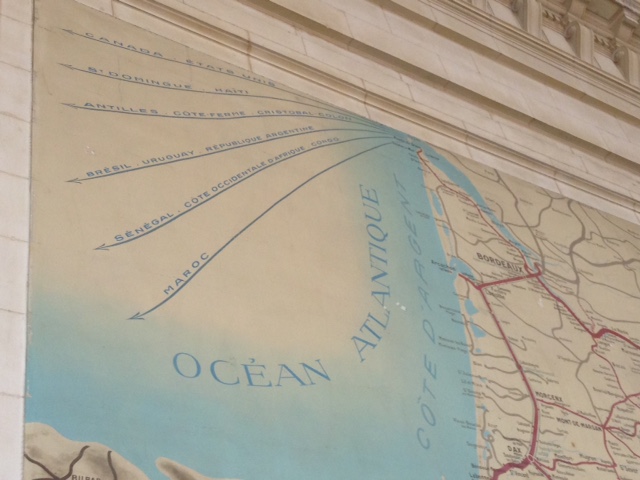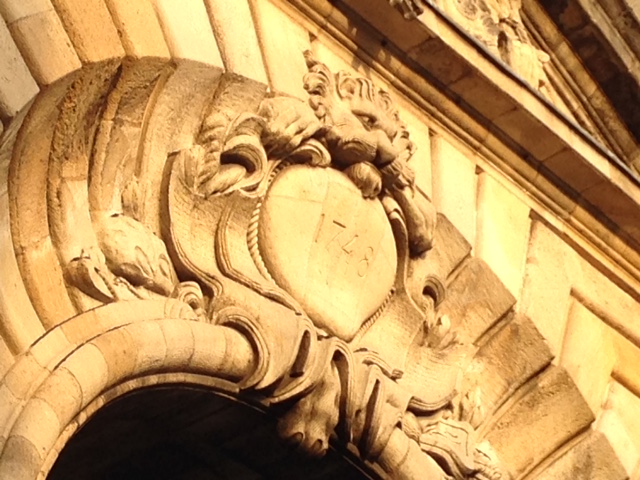
A train station mural continues to remind visitors of Bordeaux’s historic trade routes and overseas involvements in Africa and the Caribbean
In May, I participated in a conference in Bordeaux, Self, other and elsewhere: Images and imaginaries of the port cities of Atlantic and Mediterranean Europe (1700-present). [1] One particularly animated panel on the second day, “The taboo of the trade,” concerned how French ports such as Nantes and Bordeaux itself were coming to terms with their role in the Atlantic slave trade. The conference organizer, Françoise Taliano-des Garets, mentioned to me that those struggles over public memory and controversial heritage issues were a special interest of hers. The previous evening, we had attended a reception at the city hall (an eighteenth-century building, originally the archbishop’s palace). The current mayor of Bordeaux, Alain Juppé, could not attend, but sent one of his subordinates. I noticed that in her remarks, the mayor’s surrogate made a point of acknowledging the deplorable place of the slave trade in the city’s history. Afterwards, we got a tour of the Museum of Aquitaine’s newly renovated galleries relating to the slave trade era.
What I did not grasp, and am only now beginning to appreciate now that I have done some background reading, is that I had just been given a tour of a battlefield, and the memories of that battle were quite fresh. As Renaud Hourcade explains, proposals to confront the legacy of the slave trade in Nantes in the 1980s were rebuffed by a conservative city council, while Bordeaux’s elites chose to celebrate the slave trade by deploying vaguely Thatcherite language (the eighteenth-century port was dynamic, the merchants “were audacious and succeeded”). [2] According to Hourcade, the breakthrough came when a newly elected socialist mayor made Nantes “the first former slave trade port in Europe to officially commemorate slavery.” [3] An exhibit, “The Shackles of Memory,” opened in 1992 and attracted 300,000 visitors within two years.
Yet the transformation of Nantes and Bordeaux on this issue did not happen all at once, and controversy continued over just how far commemorating, or confronting, the past needed to go. Did they need to rename the streets? Should they put up a statue of Toussaint Louverture? The kind of commitment that is visible today is the result of decades of pressure from the local black community, from international students at local universities, from tireless historians and activists, and the example of other slave trade ports such as Liverpool. The publicity attending international initiatives such as UNESCO’s Slave Route Project and the Transatlantic Slave Trade Database also made it more difficult to marginalize or ignore the voyages that had originated in France.
The new galleries at the Museum of Aquitaine that we visited, for example, only opened in 2009, as part of a major initiative directed by the mayor’s office. The exhibit remarks not only upon the port’s role in the slave trade, but on the popularity of Saint-Domingue (now Haiti) as the favored destination for emigrants from the Aquitaine region; owning slaves appeared to them as a glittering prize, the poor man’s El Dorado.
In 2012, Nantes completed its Memorial to the Abolition of Slavery on the site of an old dock. It consists of 2,000 plaques (including one for each slave trade ship that departed from the port), the word “freedom” in 40 languages, and an underground chamber “to recall the slaves’ captivity.” [4] There is no memorial of equivalent stature in Bordeaux; Hourcade mentions “a small and almost unnoticeable bronze plaque” on the riverfront stating that “the city of Bordeaux honors the memory of the African slaves who were inhumanely deported to the Americas,” and he is right—despite my avid tourist gaze, I missed it. [5]

The yellow stone façades of Bordeaux’s opulent eighteenth-century architecture dominate much of the city center even today
When we think of maritime heritage, I think the image that leaps to the minds of most people would still be of historic ships such as HMS Victory. There is a very interesting backstory to just when, and why, the idea of open-air museums of historic ships caught on, and it is deeply intertwined with the history of the Society for Nautical Research and of the National Maritime Museum. Even in the early days, maritime heritage had a “culture wars” element to it, salvaging the lost values of the Age of Sail in an urbanizing, industrializing democracy. [6] But in our era, “maritime heritage” has become a much more ambiguous category, eliciting ambivalent responses. Consider Bordeaux’s sharp transition, within just 30 years, from boasting about their merchant-entrepreneurs to developing museum exhibits as hard-hitting as the Museum of Aquitaine’s.
Ana Lucia Araujo’s edited volume, Politics of Memory: Making Slavery Visible in the Public Space offers a fascinating overview, in English, of how maritime heritage and social justice are (more or less awkwardly) cohabiting today. [7] Her contributors cover Africa, South America, the United States, the Caribbean, and Europe, as well as the Indian Ocean island of Mauritius. Telling the slave trade story as a local story seems to make people uncomfortable in a unique way. Madge Dresser’s well-known work on publicizing the slave trade or slave ownership connection behind familiar statues and street names in Bristol and London has analogues in many port towns around the Atlantic basin, but the public response is often very mixed. [8]
An even more fraught topic, of course, is asking “what is the endpoint of the story of slavery?” At the Bordeaux conference, Hourcade remarked on Liverpool’s International Slavery Museum’s reputation for taking a “militant” stance, confronting the experiences of the enslaved and addressing different forms of racism and inequality that persisted long after the formal abolition of slavery in the Americas. [9] In Manhattan, the African Burial Ground, where an estimated 20,000 persons were laid to rest, has become the first U.S. National Monument dedicated to people of African descent. The last burial there was in 1794. Yet the legacies of slavery in New York City also include the Draft Riots of 1863 (which targeted African Americans) and, some would argue, incidents of police brutality that are considerably more recent. On the NYC subway, a poster advertising one historical exhibit emblazoned these words: “Slavery—It Happened Here.” A passerby added the words “… and it’s still happening.”[10]
The controversy over a statue of Sally Bassett erected in Bermuda in 2009 encapsulates both how far we have come, and how much ground remains. An enslaved 68-year-old woman, Bassett was burned to death in 1730 “for allegedly poisoning the masters of her enslaved granddaughter.” [11] Bassett experienced a surreal afterlife in white Bermudian culture as a dinner bell—her skirt formed the body of the bell. Morphing the rebellious poisoner into a grotesque reminder of continuing servitude and obedience clearly appealed to some people; a ring of the bell would summon a black maid. Sally Bassett dinner bells were popular souvenirs sold to tourists in twentieth-century Bermuda. [12] The recent initiative to restore Sally Bassett’s dignity involved a ten-foot-tall statue entitled “Spirit of Freedom.” Bassett, depicted at the moment of her execution, levitates “above flames with her hands chained behind her back…” [13] Yet the statue had its critics, who warned that the local economy depended on the white tourist dollar, and a statue of a fierce and defiant black woman being burned to death by white people would make them uncomfortable on their vacation. [14]
Notes
[1] Soi, l’autre et l’ailleurs: Images et imaginaires des villes portuaires de l’Europe atlantique et méditerranéenne (XVIIIe – XXIe siècles).
[2] Renaud Hourcade, “Commemorating a Guilty Past: The Politics of Memory in the French Former Slave Trade Cities,” in Ana Lucia Araujo, ed. Politics of Memory: Making Slavery Visible in the Public Space (New York: Routledge, 2012), 124-140, cited pages 127-128.
[3] Hourcade, “Commemorating,” 128.
[4] Hourcade, “Commemorating,” 129.
[5] Hourcade, “Commemorating,” 132.
[6] Kevin Littlewood and Beverley Butler, Of Ships and Stars: Maritime Heritage and the Founding of the National Maritime Museum Greenwich (London: Athlone, 1998), 1-50; Hugh Murphy and Derek J. Oddy, The Mirror of the Seas: A Centenary History of the Society for Nautical Research (London: Society for Nautical Research, 2010), 32, 76-78; Martin Bellamy, “Financing the Preservation of Historic Ships,” Mariner’s Mirror 97, no. 1 (February 2011), 344-365.
[7] As noted above, Araujo’s volume is (New York: Routledge, 2012).
[8] Madge Dresser has published a number of works in this area, for example “Set in Stone? Statues and Slavery in London,” History Workshop Journal 64, no. 1 (2007), 162-199. For the mixed reception, see Araujo’s own chapter in Politics of Memory, “Transnational Memory of Slave Merchants: Making the Perpetrators Visible in the Public Space,” 15-29.
[9] Interestingly, this “militant” museum evolved out of a Transatlantic Slavery Gallery that opened in 1994 in the basement of the Merseyside Maritime Museum: see Richard Benjamin, “Museums and Sensitive Histories: The International Slavery Museum,” in Araujo, ed. Politics of Memory, 181.
[10] Kathleen Hulser, “Exhibiting Slavery at the New-York Historical Society,” in Araujo, ed. Politics of Memory, 232-250, quoted page 244.
[11] Quito Swan, “Smoldering Memories and Burning Questions: The Politics of Remembering Sally Bassett and Slavery in Bermuda,” in Araujo, Politics of Memory, 71-91, quoted page 71.
[12] Swan, “Smoldering Memories,” 81.
[13] Swan, “Smoldering Memories,” 71.
[14] Swan, “Smoldering Memories,” 87.










Great post Isaac. I also went to the exhibition in Bordeaux you discuss. I felt much of the narrative focused on emphasising how much more involved other European port cities were in the transatlantic slave trade – especially Nantes. The narrative about Bordeaux’s involvement in transatlantic slavery is, I feel, still echoing that earlier interpretation; that any involvement Bordeaux had was due to its successful involvement in (and ‘proud heritage’ of) mercantile trade – as if a part in transatlantic slavery occurred by accident. Part of the complications and contradictions arising from deriving ‘pride’ from maritime history.
Thanks, Jessica! I wonder if the Bordeaux exhibit is a moving target. It opened in 2009 and I saw it in 2015. By then, there was maybe an opportunity to absorb some of the early critiques and feedback? There was a room with a video installation about the captives’ experiences and quotes on the walls from Nelson Mandela and others, reminiscent of the Liverpool museum. At least with published work we can distinguish between different editions–hard for a museum to flag what they’ve changed, if anything.